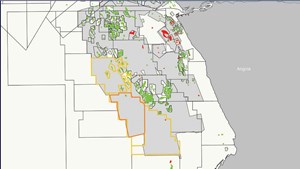PGS expands 3D data coverage in Lower Congo basin with “favorable” exploration potential
(WO) – PGS has added over 4 200 km2 of 3D data to its regional MegaSurvey dataset over Block 33 in the deepwaters of the Lower Congo basin.

The additional 4 238 km2 of 3D data released by PGS in partnership with ANPG covers open acreage that is available for direct award from ANPG through its Permanent Offer regime. Total coverage of the Angola MegaSurvey dataset now stands at over 49,500 km2
The data extension covers the majority of Block 33, which is located outboard and south of the prolific blocks 17 and 32. Combined, these currently produce around 550 000 bopd from post-salt Oligo-Miocene plays. Block 33 contains just six well penetrations, which have yielded two Oligo-Miocene oil discoveries, and is highly underexplored in comparison to the neighboring acreage.
Targeting the deeper stratigraphy. No well in the deepwater Lower Congo basin has yet penetrated the pre-salt megasequence, and few wells have tested the post-salt Cretaceous section. One such test of the Cretaceous post-salt, however, has proven excellent source rocks with high oil potential in the Lower Albian aged stratigraphy on Block 33.
Upper Cretaceous-aged reservoirs are highly productive in the shelfal areas of the Lower Congo basin and could be meaningful exploration targets in the outboard. Block 33, located on the flank of the main Congo Fan depocenter, is a favorable area for these deeper targets. Here, overburden is less, and seismic imaging challenges are fewer due to reduced halokinesis of the Loeme Formation salt.
Permanent offer coverage. The Angola MegaSurvey also provides 3D data coverage over neighboring Permanent Offer blocks 32 and 34, where the same plays can be targeted. The regional Angola MegaSurvey provides the means to evaluate these open blocks in a cost-effective manner utilizing a consistent, amplitude and phase-balanced dataset.
Lead image: Ramform Atlas is towing 10 densely spaced streamers each over 8 km long near the plume of the Congo River (Source: PGS)


